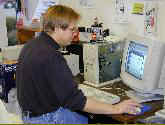Computer Corner #21
By Bob Habas
Formally of computer Connections

Windows Explorer
(not to be confused with INTERNET Explorer), is the built-in 'File Manager'
that allows Windows users to peruse, copy, delete, and move files throughout
folders and hard drives on their laptops and desktop workstations. You can
customize the look you want with Windows Explorer by adding 'switches',
or extended commands to the Target line on the Property Sheet of Explorer.
Just copy and paste the bold text into the Target line on the Property Sheet.

If it's not what you expected you can always
switch back to the default view by using C:\Windows\explorer.exe
in the Target line.
"My Computer" highlighted in left side with all drives visible but
not expanded and C: highlighted in right side: C:\Windows\explorer.exe
/e,/select,c:

Desktop highlighted and nothing expanded:C:\Windows\explorer.exe
/e,/n,/select,/root,c:

All drives visible and the system drive highlighted and expanded in full
screen: C:\Windows\explorer.exe /e,/select
All drives visible and the system drive
expanded in small screen: C:\Windows\explorer.exe /e,/select,C:\Windows

Only Windows Directory visible highlighted and expanded: C:\Windows\explorer.exe
/e,/root,C:\Windows

All drives visible but only C: highlighted and expanded: C:\Windows\explorer.exe
/e,c:

Nothing expanded and My Computer
highlighted in right side: C:\Windows\explorer.exe /n,/e,/select,

Opens the Windows folder as a folder: C:\Windows\explorer.exe
C:\Windows

Play around with the switches and see if one of the views is what
you're seeking. Remember, if it's not what you expected you can always switch
back to the default view by using C:\Windows\explorer.exe in
the Target line.
Return
To Main Page
Compute 20 - Skype










